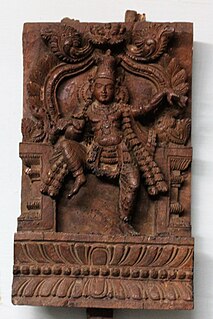
Sambandar or Thirugnana Sambandar was a young Saiva poet-saint of Tamil Nadu who lived around the 7th century CE.
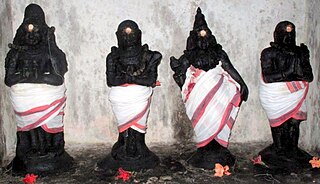
Thirumurai is a twelve volume compendium of songs or hymns in praise of Shiva in the Tamil language from the 6th to the 11th century by various poets in Tamil Nadu. Nambi Andar Nambi compiled the first seven volumes by Appar, Sampandhar and Sundarar as Tevaram during the 12th century. During the course of time, a strong necessity was felt by scholars to compile Saiva literature to accommodate other works. Tiruvasakam and Tirukovayar by Manickavasagar are included as the eighth, nine parts are compiled as the ninth Tirumurai out of which most are unknown, and the tenth as Tirumandiram by Tirumular, the famous Siddhar. The eleventh is compiled by Karaikal Ammaiyar, Cheraman Perumal and others. The contemporary Chola king was impressed by the work of Nambi and included Nambi's work in the eleventh Tirumurai. Sekkizhar's Periya Puranam, composed a century later, contains the life depiction of all the 63 Nayanmars. The response for the work was so tremendous among Saiva scholars and Kulothunga Chola II that it was included as the 12th Tirumurai. Tirumurai along with Vedas and Saiva agamas form the basis of Saiva Siddantha philosophy in Tamil Nadu.

The Nayanars were a group of 63 saints living in Tamil Nadu during the 6th to 8th centuries CE who were devoted to the Hindu god Shiva. Along with the Alwars, their contemporaries who were devoted to Vishnu, they influenced the Bhakti movement in early medieval South India. The names of the Nayanars were first compiled by Sundarar. The list was expanded by Nambiyandar Nambi during his compilation of material by the poets for the Tirumurai collection, and would include Sundarar himself and Sundarar's parents.

The Periya Puranam, that is, the great purana or epic, sometimes called Tiruttontarpuranam, is a Tamil poetic account depicting the lives of the sixty-three Nayanars, the canonical poets of Tamil Shaivism. It was compiled during the 12th century by Sekkizhar. It provides evidence of trade with West Asia The Periya Puranam is part of the corpus of Shaiva canonical works.
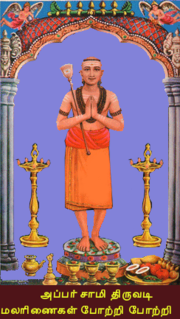
Appar Tirunavukkarasar Nayanar, also known as Navukkarasar and Appar, was a seventh-century Śaiva Tamil poet-saint, one of the most prominent of the sixty-three Nayanars. He was an older contemporary of Thirugnana Sambandar. His birth-name was Marulneekkiyar. He was called "father" by Sambandar, hence the name Appar.
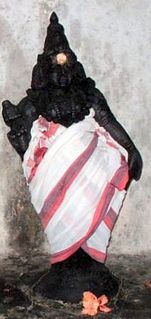
Sundarar, also known affectionately as Tampiran Tōḻan was an eighth-century poet who was one of the most prominent Nayanars, the Shaiva bhakti (devotional) poets of Tamil Nadu. He was a contemporary of Cheraman Perumal and Kotpuli Nayanar who also figure in the 63 Nayanmars. The songs of praise are called Thiruthondathogai and is the original nucleus around which the Periyapuranam is based. The Periya Puranam, which collects the legends of the Nayanars, starts and ends with him. The hymns of seventh volume of the Tirumurai, the twelve-volume compendium of the poetry of Tamil Shaiva Siddhanta, were composed by him. His songs are considered the most musical in Tirumurai in Tamil language.

The Thevaram denotes the first seven volumes of the Tirumurai, the twelve-volume collection of Śaiva devotional poetry. These volumes contain the works of the three most prominent Tamil poets of the 7th and 8th centuries: Sambandar, Appar, and Sundarar. The three poets were not only involved in portraying their personal devotion to Shiva, but also engaged a community of believers through their songs, and their work is an important source for understanding the emergence of the Bhakti movement in early medieval South India.
Thirunaraiyur Nambiyandar Nambi was an eleventh-century Shaiva scholar of Tamil Nadu in South India who compiled the hymns of Sampantar, Appar and Sundarar and was himself one of the authors of the eleventh volume of the canon of the Tamil liturgical poetry of Shiva, the Tirumurai.
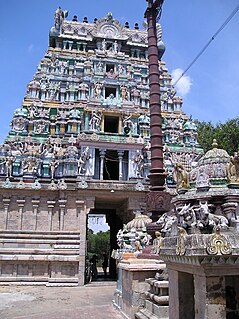
Kalyanasundaresar Temple, Nallur or Thirunallur is a Hindu temple dedicated to the deity Shiva, located in Nallur, in the outskirts of Kumbakonam in Tamil Nadu, India. Shiva is worshiped as Kalyansundaresar, and is represented by the lingam. His consort Parvati is depicted as Girisundari. The presiding deity is revered in the 7th century Tamil Saiva canonical work, the Tevaram, written by Tamil saint poets known as the nayanars and classified as Paadal Petra Sthalam. The legend of the temple is associated with sage Agastya and Amaraneethi Nayanar, one of the 63 nayanars, the Tamil Saiva saints. The lingam in the temple is believed to change colours five times during the day time.

Vedapuriswarar Temple, Thiruvedhikudi or Vazhaimadunathar Temple is a Hindu temple dedicated to Shiva located in Thiruvedhikudi near Tiruvaiyaru, Tamil Nadu, India. The presiding deity is revered in the 7th century Tamil Saiva canonical work, the Tevaram, written by Tamil poet saints known as the nayanars and classified as Paadal Petra Sthalam. The temple is counted as the earliest of all Chola temples.

Tirunallar Saniswaran Temple or Dharbaranyeswarar Temple is a Hindu temple dedicated to Lord Shani (saturn) located in Tirunallar in Karaikal district of Pondicherry, India. The presiding deity is Shiva, Dharbaranyeswar and the place Tirunallar was historically called Dharbaranyam. The temple is revered by the hymns of 7th century Tamil saivite poets, Appar, Sundarar and Sambandar and is classified as Paadal Petra Sthalam.
Muruga Nayanar or Muruka Nayanar is the 15th Nayanar saint. Traditional hagiographies like Periya Puranam and Thiruthondar Thogai describe him as a great devotee of the Hindu god Shiva. He is described to have lived an ascetic life, filled with austerity and selfless devotion to Shiva, spending his time in collecting flowers from woodlands and decorating the Shiva Lingam with garlands and coronets.

Padikasu Nathar Temple is a Hindu temple located at Azhagaputhur, a village in the Thanjavur district of Tamil Nadu, India. Shiva is worshiped as Padikasunathar, and is represented by the lingam. His consort Parvati is depicted as Soundaranayagi. The presiding deity is revered in the 7th century Tamil Saiva canonical work, the Tevaram, written by Tamil saint poets known as the nayanars and classified as Paadal Petra Sthalam. The 8th century Saiva saint poet Sundarar has sung praise about the temple in his works.
Kungiliya Kalaya Nayanar, also known as Kungiliya Kalaya, Kalayar, Kunguliya and Kalaya Nayanar, is a Nayanar saint, venerated in the Hindu sect of Shaivism. He is generally counted as the eleventh in the list of 63 Nayanars.

Isaignaniyar, also spelt as Isainaniyar, Isaignaniyaar, Isaignaniar and Isaijnaniyar and also known as Isai-jnani Ammaiyar, is the mother of Sundarar, one of the most prominent Nayanar saints. She is herself regarded as a Nayanar saint, venerated in the Hindu sect of Shaivism, along with her husband Sadaiya Nayanar. She is generally counted as the last in the list of 63 Nayanars.

Sadaiya Nayanar - 7th century, also known as Sadaya Nayanar, Sadaiyan (Cataiyan), Sadaiyanar (Cataiyanar) is the father of Sundarar, one of the most prominent Nayanar saints. He is himself regarded as a Nayanar saint, venerated in the Hindu sect of Shaivism, along with his wife Isaignaniyar. He is generally counted as the sixty-second in the list of 63 Nayanars, Isaignaniyar being the last Nayanar. Sundarar is the only Nayanar with both his parents enlisted as Nayanars. The inclusion of Sadaiya Nayanar, streams solely on the basis on his association with Sundarar, rather than individual merit.
Viralminda Nayanar, also known as Viranmindar (Viranmintar), Viranmintan and Viranminda Nayanar, is a Nayanar saint, venerated in the Hindu sect of Shaivism. He is generally counted as the sixth in the list of 63 Nayanars. He was a contemporary of Sundarar. He along with Cheraman Perumal Nayanar are the two Nayanars from Kerala. Viralminda Nayanar is described in legends as the reason Sundarar composed a hymn to the Nayanar saints, which became the first compilation of the list.
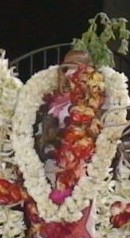
Tirunilakanta Nayanar, also known as Tirunilakanta, Nilakantan and Tirunilakantar (Thiruneelakandar) was a Nayanar saint, venerated in the Hindu sect of Shaivism. He is generally counted as the second in the list of 63 Nayanars.
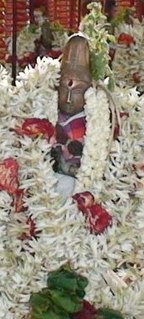
Tiruneelanakka Nayanar, also known Tiruneelanakka, Nilanakkar and Nilanakkan, was a Nayanar saint, venerated in the Hindu sect of Shaivism. He is generally counted as the twenty-eighth in the list of 63 Nayanars. He is described as a contemporary of Sambandar, one of the most prominent Nayanars.
Tiruppanantaal Arunajadewswarar Temple is a Hindu temple located at Tirupanandal in Thanjavur district of Tamil Nadu, India. The historical name of the place is Thadagaieswaram. The presiding deity is Shiva. He is called as Aruna Jadewswarar. His consort is known as Periya Nayaki.












